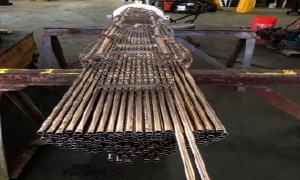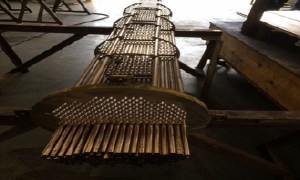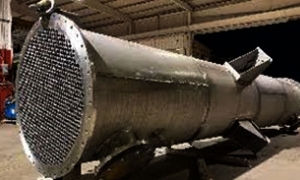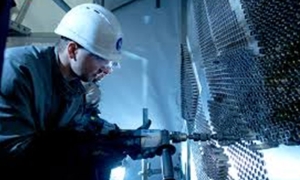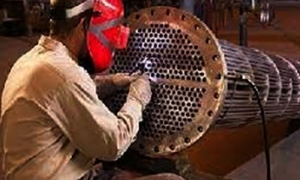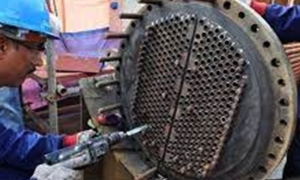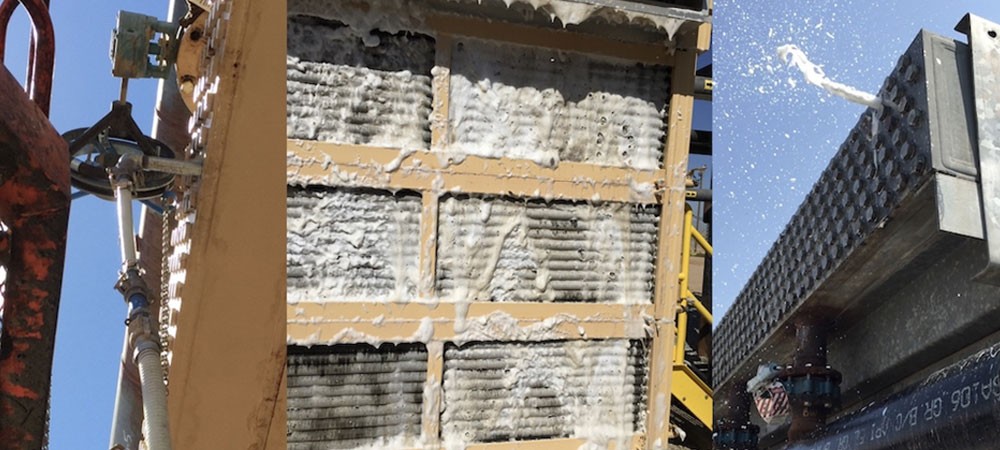Heat Exchange Re-tubing
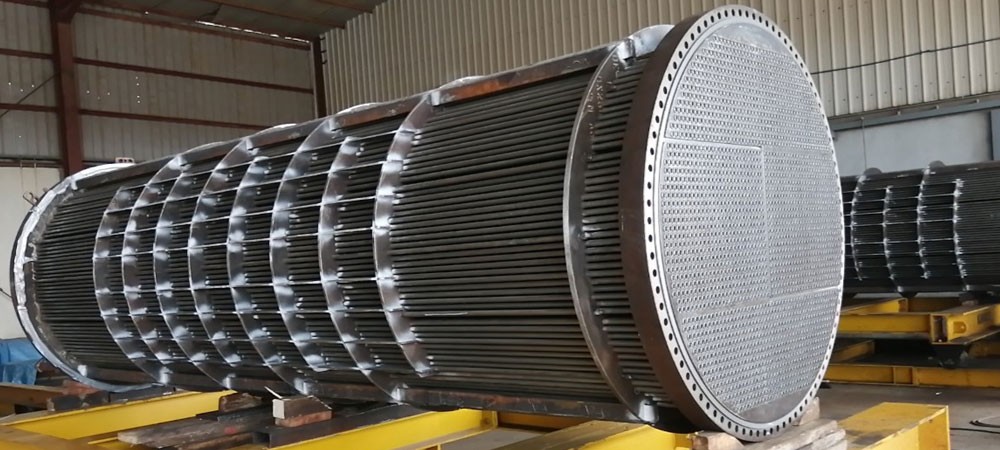
Heat Exchange Re-tubing
Heat exchanger tubes are constantly expanding and contracting as they heat up and cool down during normal operations. Depending on the application, saltwater scale, calcium, Lyme and other contaminants can compound the problem, leading to even faster deterioration. Over time, these factors inevitably lead to failure and the tubing must be replaced.
Condenser & Chiller Services offers complete, on-site heat exchanger retubing service. We retube, service, and repair heat exchangers from most major manufacturers. Our technicians:
- Remove damaged, corroded, or worn-out tubes
- Clean and prep tube sheets
- Provide the replacement tubes you need (or work with customer-supplied tubes)
- Install new tubing
- Assist in pressure or hydro testing the heat exchanger
- Evacuate, charge, and restart the system
- Recycle old tubing materials and provide you with a salvage credit that can be deducted from your final bill
We stock an extensive inventory of Cal-Fin tubes, in a range of alloy materials that meet ASME B111 or AMSE B543 specifications. We have u-bending capabilities to transform straight tubes into the curved tubes many heat exchanger designs require. We can furnish replacement tubing, or work with the tubing you provide.
In every heat exchanger retubing process, we try to upgrade the tubing for improved energy efficiency. In many cases, a better alloy will give you a prolonged life span of the unit. We will work with you to find the right balance of performance and durability for your specific application.
To reduce the cost of heat exchanger retubing, we also offer eddy current tube analysis. An eddy current test will identify which tubes need to be replaced and which can remain in service.
HEAT EXCHANGER & RETUBING SERVICES
The heat exchanger maintenance consists in cleaning the bundle of inner tubes and the outer cleaning of the cloak.
The maintenance procedure is carried out in three phases:
- tube bundle extraction
- tube bundle transport
- bundle cleaning
- tube insert
A heat exchanger is an apparatus where the exchange of heat energy
occurs between two different fluids at different temperatures.
The most used is what
is known as a tubular beam and cloak exchanger, as its large surface structure allows
to exchange of large quantities of heat.
This type of exchanger has a cylindrical shape,
formed by a container called the mantle, where a bundle of tubes passes through each of
them, both of which are crossed by the fluids.
1 Tube bundle extraction procedure
The bundle extractor or bundle puller consists in extracting the exchanger from its shell
through the
Ad hoc machines, called aerial tube bundle extractors have a variable pull power,
depending on the size of the exchanger itself.
2 Tube bundle transport procedure
The tube bundle transport procedure can be carried out in two different ways, depending on
the height where the exchanger is located.
For large heights, the transport will be
carried out first by using cranes and later with ad hoc called straddle carrier cars, for lower heights, it would be enough to use truck mounted or self-propelled.
3 Tube bundle cleaning procedure
The cleaning process of the tube bundles consists of the pulp of the same thanks to robots that wash away the deposits both internally and externally, through high-pressure jet jets.
4 Tube insertion procedure
The insertion of the bundle consists in re-inserting the exchanger into its own shell through the aerial bundle extractor itself after the cleaning phase.
In an ideal world, all of our essential machinery would continue operating indefinitely with no need for repair or replacement. However, in reality, all machinery has a finite lifespan. This is where heat exchanger maintenance activities are vital.
A heat exchanger requires maintenance to keep it running efficiently. Fouling, corrosion, or other damage will reduce the performance of the heat exchanger. Maintenance also helps to prevent emergency repairs which would cause downtime.
Some types of heat exchangers last longer than others. It depends on the design, the application, and the materials involved. However, every heat exchanger will wear out eventually, and maintenance, repair or replacement will be required.
This article explains the degradation of a heat exchanger and tells you when and how you should maintain them to avoid the need for serious repair. Well also look at whether a heat exchanger can be repaired, outlining a repair process for heat exchangers that have already failed.
HEAT EXCHANGER & RETUBING SERVICES
Heat exchangers are at the heart of many critical industrial systems. From power plants to industrial chemical plants and everything in between, the heat exchanger in all its forms is a critical aspect of heat management systems. Therefore, all organizations must take heat exchanger maintenance extremely seriously, because a heat exchanger failure can be a potentially deadly event due to risks of fire and explosions. Proper cleaning is essential in making sure that your heat exchanger is functioning properly and efficiently.
Heat exchangers work in many ways, but their essential function is always the same; heat exchangers allow systems to transfer heat out so that they can maintain temperature and pressure. The buildup of waste products, however, such as oil or dirt, can keep these systems from working properly. From clogging or hampering internal mechanisms to bridging heat exchange gaps, the industrial and environmental buildup can silently and quickly compromise a heat exchanger's ability to perform its function which can cause harmful heat buildup within the system.
Heat exchanger cleaning is a complex, multi-stage process that involves many steps. Further, proper cleaning must be carried out by a certified technician so that there is a certainty that all steps are performed fully and that all regulations are followed. A few of the things that a heat exchange technician will perform include:
Multiple inspections. From as-found inspections that document the conditions of the heat exchanger when the technician arrives, to post wipe-down and after-job inspections, the heat exchanger technician will carefully inspect and document the state of the heat exchanger throughout the entire heat exchanger maintenance process. This helps managers and maintenance personnel to understand the condition of their equipment, to better predict when maintenance will be necessary, and to develop an overall picture of the health of their heat exchange systems.
Complete tube cleaning and coating. The exchanger tubes are essential for all heat exchangers, and these tubes must remain clean and properly coated to ensure that the exchange of heat happens efficiently. Thus, heat exchanger cleaning technicians will perform thorough cleaning and re-coating of all exchanger tubes, utilizing only industry-certified techniques and materials.
Cover removal, cleaning, inspection, replacement, and tube plugging. The tube covers must be clean to ensure that there are no breaks in containment seals. Thus, heat exchange maintenance professionals will perform a thorough review of all aspects of the covers, cleaning and repairing or replacing them as necessary.
Heat exchanger maintenance and cleaning is a complex procedure that must be carried out by licensed, experienced professionals. Any mistake made during the maintenance procedure can have lasting and drastic consequences if they result in a heat exchanger failure. That is why all heat exchanger professionals are licensed, certified technicians before they are allowed to work in the field.
